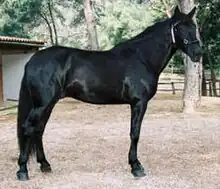Mallorquín
The Mallorquín or Caballo Mallorquín (Catalan: Cavall Mallorquí) is a rare breed of horse indigenous to the island of Mallorca in the Balearic Islands, from which it takes its name. Identification of the breed was begun in 1981 by the Patronato para las Razas Autóctonas de Mallorca ("authority for the autochthonous breeds of Mallorca"). The Mallorquín is listed in the Catálogo Oficial de Razas de Ganado de España in the group of autochthonous breeds in danger of extinction.[5]
 | |
| Conservation status | |
|---|---|
| Other names |
|
| Country of origin | Spain |
| Distribution | Mallorca, Balearic Islands |
| Standard | Dirección General de Recursos Agrícolas y Ganadero (in Spanish) |
| Use | riding horse |
| Traits | |
| Height | |
| Colour | black[4]: 483 |
History
The origins of the breed are obscure. According to a genetic study of "Spanish Celtic horse breeds", the Mallorquín and Menorquín are connected to the now extinct Catalan horse,[6] itself the result of introgression of populations with strong African genetic influence into an original population of Celtic horses introduced to the Iberian peninsula by the Celts in about the eighth century BC.[7] The study showed clear grouping of the two Mediterranean breeds and clear separation from the five "Atlantic" Celtic breeds examined, the Asturcón, Gallego, Jaca Navarra, Losino and Pottok.[8]
Identification of the breed was begun in 1981 by the Patronato para las Razas Autóctonas de Mallorca ("authority for the autochthonous breeds of Mallorca").[3]: 483 A stud-book was started in 1988,[9] and a breed association, the Associació de criadors i propietaris de cavalls de pura raça Mallorquina, was established in 1992.[3]: 482 The official breed standard was approved in 2003.[9]
The Mallorquín is listed in the Catálogo Oficial de Razas de Ganado de España in the group of autochthonous breeds in danger of extinction.[5][10] Its status was listed as "critical-maintained" by the Food and Agriculture Organization of the United Nations in 2000 and in 2007.[11]: 401 [12] In approximately 2005 the number of Mallorquín horses recorded in the stud-book was 247, but a census conducted by the Ministerio de Medio Ambiente y Medio Rural y Marino in 2003 identified only 172.[13] In 2010 a population of 146 was reported,[4]: 483 which by 2018 had risen to 320.[2]
Characteristics
The Mallorquín may only be black, in all its variations; horses of any other colour can not be registered. Limited white facial markings are permitted, white leg markings are not. The minimum permissible height is 1.52 metres (15.0 hands) for males and 1.48 m (14.2 h) for females.[14] It has an upright mane, short, thick, but arched neck, a head with a convex profile but refined bone structure. Its conformation relates to that of the Andalusian horse[15]
Uses
This breed is used by the local population only as a riding horse; farm work in the islands was traditionally done by the Balearic donkey.[16] Mallorquín mares were traditionally bred to imported stallions, usually of French Trotter or Orlov Trotter breed, to produce Trotador Español, "Spanish Trotter", horses. Approximately 85% of the Spanish Trotter population is in Mallorca; however, genetic study has found little recent influence of the Mallorquín on the Spanish Trotter breed.[13] They were also much used in the production of mules.[3]: 483
References
- Barbara Rischkowsky, D. Pilling (eds.) (2007). List of breeds documented in the Global Databank for Animal Genetic Resources, annex to The State of the World's Animal Genetic Resources for Food and Agriculture. Rome: Food and Agriculture Organization of the United Nations. ISBN 9789251057629. Accessed January 2017.
- Breed data sheet: Cavall Mallorquí / Spain (Horse). Domestic Animal Diversity Information System of the Food and Agriculture Organization of the United Nations. Accessed March 2020.
- Miguel Fernández Rodríguez, Mariano Gómez Fernández, Juan Vicente Delgado Bermejo, Silvia Adán Belmonte, Miguel Jiménez Cabras (eds.) (2009). Guía de campo de las razas autóctonas españolas (in Spanish). Madrid: Ministerio de Medio Ambiente y Medio Rural y Marino. ISBN 9788449109461.
- Valerie Porter, Lawrence Alderson, Stephen J.G. Hall, D. Phillip Sponenberg (2016). Mason's World Encyclopedia of Livestock Breeds and Breeding (sixth edition). Wallingford: CABI. ISBN 9781780647944.
- Ganaderia: Clasificación de Razas (in Spanish). Ministerio de Medio Ambiente y Medio Rural y Marino. Archived 16 January 2011.
- J.M. Martinez, M. Valera, A. Molina (1996). 'El caballo Losino' Animal Genetic Resources Information 19: 17–27. Cited by Cañon, not consulted.
- S. Aran (1949). Caballos, mulos, asnos. Madrid: Gráficas Yagües. Cited by Cañon, not consulted.
- J. Cañon, M.L. Checa, C. Carleos, J.L. Vega-Pla, M. Vallejo, S. Dunner (February 2000). The genetic structure of Spanish Celtic horse breeds inferred from microsatellite data. Animal Genetics 31 (1): 39–48. doi:10.1046/j.1365-2052.2000.00591.x.
- Razas Autóctonas de las Illes Balears (in Spanish). Govern de las Illes Balears: Dirección General de Agricultura, Ganadería y Desarrollo Rural. Accessed July 2019.
- Raza equino caballar Mallorquina (in Spanish). Ministerio de Agricultura, Pesca y Alimentación. Accessed July 2019.
- Beate Scherf (editor) (2000). World Watch List for domestic animal diversity. third edition. Rome: Food and Agriculture Organization of the United Nations. ISBN 9251045119. Accessed April 2011.
- Critical Breeds List 2007. Rome: Food and Agriculture Organization of the United Nations. Accessed April 2011.
- Pedro Javier Azor, Mercedes Valera, María Dolores Gómez, Félix Goyache, Antonio Molina (2007). Genetic characterization of the Spanish Trotter horse breed using microsatellite markers. Genetics and Molecular Biology 30 (1): 37–42. doi:10.1590/s1415-47572007000100009.
- Orden del Consejero de Agricultura y Pesca de, 12 de junio de 2003, por la que se establecen las normas zootecnicas del caballo de Pura Raza Mallorquina (in Spanish). Ministerio de Medio Ambiente y Medio Rural y Marino. Archived 22 March 2012.
- Estudio y caracterizacion del sectór equino en España (in Spanish) Ministerio de Agrícultura, Pesca y Alimentacíon
- Traditions and fiestas. Consell Insular de Menorca. Archived 2 May 2003.